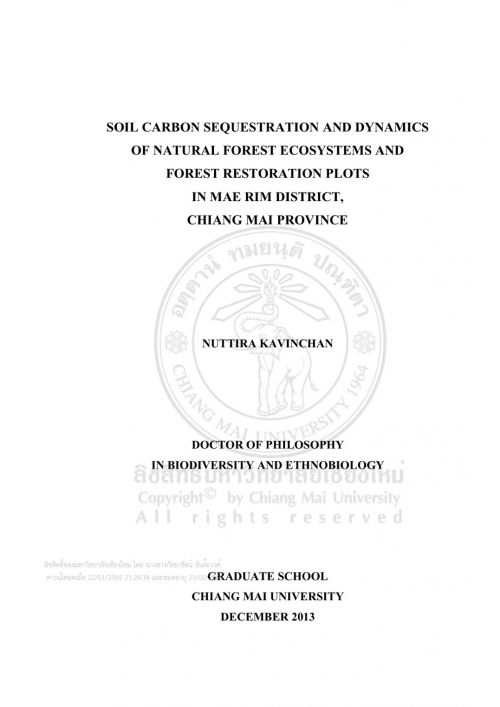Soil carbon sequestration and dynamics of natural forest ecosystems and forest restoration plots in Mae Rim District, Chiang Mai Province

FORRU Contributors
ABSTRACT: The study of below-ground carbon sequestration was conducted in a forest that was restored using framework species method of Forest Restoration Research Unit (FORRU), Ban Mae Sa Mai, Mae Rim district, Chiang Mai. Plots of three different ages: 11, 7 and 2 years since planted, natural forest and control (non-planted) plots were chosen. Litter traps (1 x 1 m2) were set up and plant litter was collected for 32 months (during Jun. 2009 – Jan. 2012). Litterfall accumulation of a total of 32 months in all study sites ranged from 1.54 – 17.61 t/ha. The highest amount of litterfall was found in the natural forest plot next to the 11-year, 7-year, control and 2-year-old sites, 17.61, 13.98, 13.18, 6.24 and 1.54 t/ha, respectively and carbon content of litter were 6.82, 4.96, 4.35, 2.08 and 0.53 t/ha, respectively. An old-age forest restoration plot tends to have more litter accumulation and carbon stock in term of litterfall. Litter decomposition of three representative framework species (Erythrina subumbrans, Castanopsis diversifolia and Ficus subincisa) using litterbag method was studied. Ficus subincisa decomposed more rapidly than Erythrina subumbrans and Castanopsis diversifolia, respectively. The additional part of mixed litter decomposition using big litterbag was also determined. The highest decay rate coefficient was found in 7-year-old site next to 11, control, natural forest site and 2 year-old site, 2.85, 1.27, 1.20, 1.12 and 1.08, respectively.
Moreover, soil profile in each study was determined. Soil organic carbon until 200 cm. in depth was also determined and found that the highest soil organic carbon in 2-year next to 7-year-old, natural, control and 11-year-old site, 254.40, 251.14, 244.96, 205.88 and 161.82 tC/ha.
Related Advice
Rapid site assessment
The concept and methodology to determine the level of degradation, which is related to activities should be implemented and the intensity of the work required for the target...
Biomass, Carbon Accumulation & Climate Change
About half the biomass of a growing forest is carbon – that means forest restoration can help to mitigate global climate change. Learn more here.

